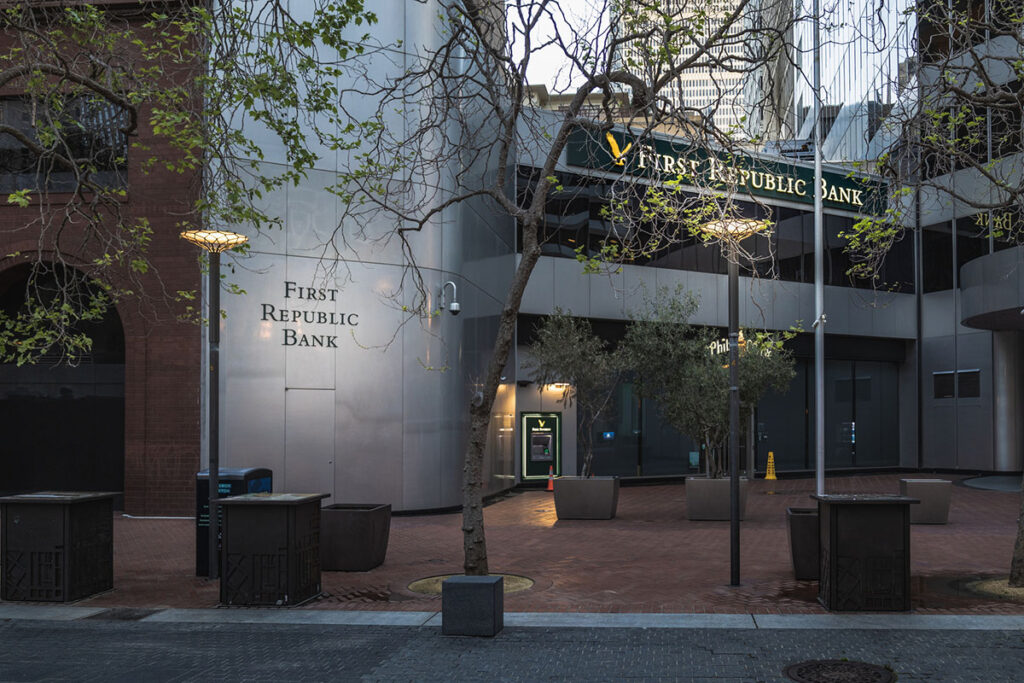First Republic Bank was a favorite of the tech industry and San Francisco society for decades. With their thick annual reports filled with photos and testimonials, cookies available in their branches, and outstanding service, customers from the Bay Area to Jackson Hole to New York City were fans. The bank rose to fame making competitive interest-only loans secured by expensive homes.
First Republic Bank (FRB) was among those regional banks most impacted after the swift collapse of Silicon Valley Bank (SVB) and Signature Bank in early March 2023. Within days, wary depositors had withdrawn over $100 billion from FRB, resulting in a massive liquidity crisis. Initially, it looked like FRB might be spared from FDIC receivership after 11 of America’s largest lenders deposited $30 billion in assets to bolster liquidity. On May 1, however, the initial rescue efforts proved futile as First Republic Bank was seized by regulators and the majority of its operations were sold to JPMorgan Chase.
The collapse of First Republic is now the second-largest bank failure in U.S. history, overtaking SVB which collapsed just over one month ago. Only the Washington Mutual failure, which occurred at the height of the 2008 financial crisis, still surpasses each of the three failures we’ve seen thus far in 2023. For now, it appears that regulators have contained the FRB issue by acting quickly to find a buyer and provide resources to assist struggling banks after the collapse of SVB.
With so much uncertainty in the air, we believe it’s important to stay informed and take appropriate steps to make sure your bank deposits are protected. Here’s what you need to know and what you can do.
Why Did First Republic Fail?
Like the SVB failure that we wrote about, several factors contributed to FRB’s collapse, including rapid interest rate hikes implemented by the Federal Reserve and the swift cash withdrawals that occurred during and after SVB’s collapse. As rates rose 9 times in just 12 months, depositors flocked to other investment vehicles offering competitive returns on cash. First Republic was forced to offer higher interest rates to keep depositors happy, while suffering major losses on its underlying investment portfolio, which consisted largely of residential real estate mortgages to wealthy individuals. The rising rate environment hurt both the deposit side and the loan side. The bank lost $100 billion in deposits in the weeks following the SVB collapse, as high net-worth customers had a fresh reminder that the FDIC only insures accounts up to $250,000.
This infographic ranks U.S. banks with the most uninsured deposits as of mid-March 2023. FRB is towards the top with over 67% of deposits uninsured, meaning most of their customers hold a lot of cash. Bank of America is near the bottom with just under 50% of their depositors uninsured. We think it’s time for the FDIC to increase their deposit insurance threshold.
How Is This Bank Different from SVB?
While the failures of SVB and Signature Bank created widespread panic among depositors and investors, the response to First Republic’s collapse has been relatively tame. The day of the FDIC’s takeover announcement, the S&P 500 Index closed mostly flat, and shares of JPMorgan Chase were up about 3%.
A notable difference between SVB and FRB is the effort made to rescue the latter; when it became apparent that FRB could not be rescued, it was sold to a much larger industry giant.
JPMorgan Chase, now the largest bank in the country, agreed to assume all of First Republic’s $92 billion in deposits. It has also purchased nearly all the bank’s assets, including $173 billion in loans and $30 billion in securities. As part of the deal, the FDIC has agreed to cover $13 billion in losses.
On Monday, May 1, all 84 First Republic branches reopened as JPMorgan Chase, and depositors at First Republic had access to their funds. Depositors do not need to file a claim or change banking relationships to maintain FDIC coverage.
How Can You Keep Your Cash Reserves Safe?
Cash reserves are an important part of a financial plan, as we wrote in The 4 Ws of Cash Management. Thankfully, there are several ways to keep your funds safe in the event of a bank or brokerage failure.
Know Your Federal Protection Limits
The Federal Deposit Insurance Corporation (FDIC) insures up to $250,000 in checking, savings, money market, and certificates of deposits held at member banks. This limit is per depositor, per bank, for each account ownership category. If you have more than this amount at any one bank, consider spreading your money across multiple banks, or working with your advisor to determine if you really need to hold that much cash.
If you were a customer of both First Republic and JPMorgan Chase prior to the takeover, review your accounts so that you don’t exceed the limits now that all your accounts are under JPMorgan Chase.
If you have more than $250,000 at one bank in one ownership category, consider moving funds to another institution or creating a second account with a different account title. For instance, you can hold more than $250,000 at a single bank if some of the funds are in a joint account versus an individual account. Overall, it’s wise to diversify your bank accounts as you would your investments.
Although not FDIC insured, Schwab’s Value Advantage, a position-traded money market account held in a brokerage account is yielding approximately 4.5% and is another great alternative for medium-term cash management. The holding does not allow check-writing privileges.
Schwab Bank
If you are unhappy with your current bank, would like to diversify your deposits, or want to consolidate your assets at one custodian, consider opening an account with FDIC insured Schwab Bank. Many of our clients keep their cash at Schwab, and we believe the company’s long-standing reputation and time-tested expertise is something we can rely on going forward. According to a recent Motley Fool article, “[h]olding more than $7 trillion of client assets, Schwab is also certainly too big to fail.” Learn more about Schwab’s response to the recent bank failures here.
Let us know if you’d like us to complete a Schwab Bank application for your signature.
Does Your Portfolio Have Exposure to First Republic Bank?
Assets under our management are always well diversified. Holdings within Dimensional portfolios are broadly diversified, as well. Individual security weights in the portfolios are linked to market capitalization weights, which reflect the latest market assessment of the tradeoffs between expected returns and risks. Broad diversification helps reduce idiosyncratic exposure to any single stock and can be critical to capturing the premiums associated with company size, relative price, and profitability.
As of January 31, 2023, some Dimensional equity funds had holdings in regional banks, including First Republic, but the weight was much less than the 2% allocation in the Russell 3000 Index. Dimensional’s fixed income funds do not have any exposure to First Republic Bank.
First Republic has stopped trading as of Monday, May 1, and shareholders will be wiped out—they will not receive stock in JPMorgan Chase. Dimensional’s traders continue to monitor the situation and follow their normal, flexible investment approach that balances a daily consideration of expected returns, diversification, and risk.
Looking Forward
While we have no insight into the activities of JPMorgan Chase, we expect that all customers with $250,000 or less on the day of the takeover will be made whole. We are here to act as a resource and to provide accurate, timely, and up-to-date information about events that can impact your financial plan and investment portfolio.
While no one can predict the future, we maintain that a long-term investment plan combined with prudent financial practices is the best way to address market volatility and safeguard your funds. If you have questions about your specific situation, please reach out.
With research and contributions from Samantha Beauvais.





